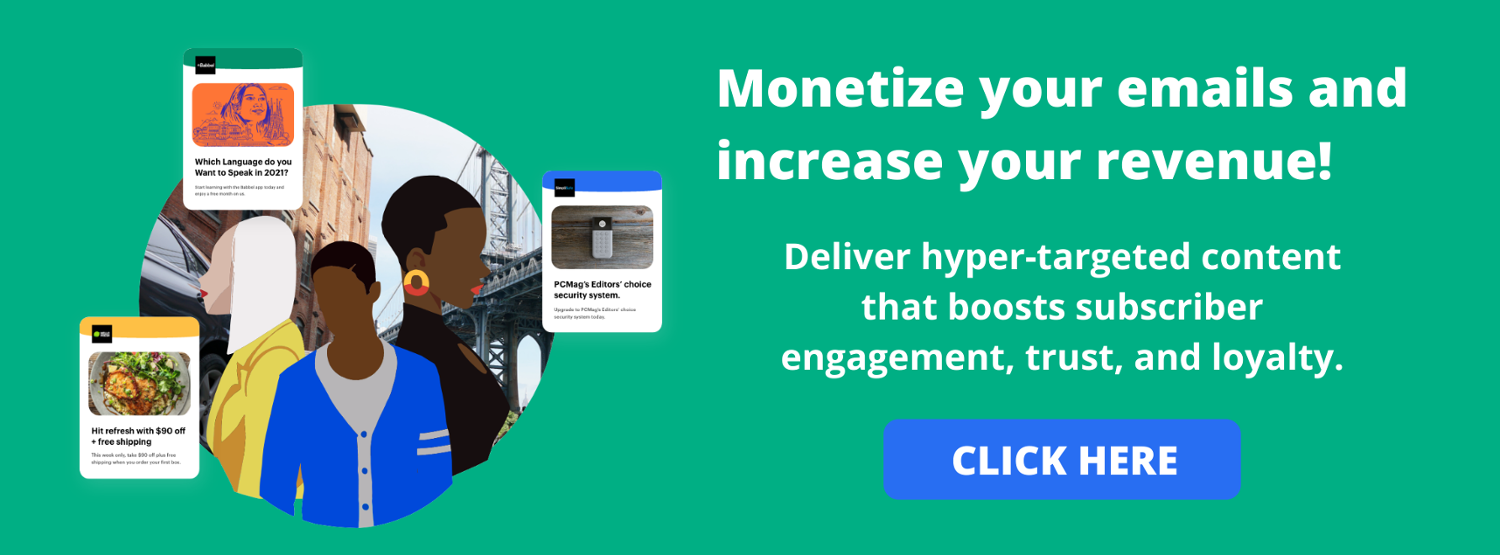There’s money in your subscribers’ inboxes. You just need the right tools to help you access it.
Even if you launch one email each week, you could be earning money from that content and contributing to your bottom line. Otherwise, you’re missing out on 52 valuable, revenue-driving opportunities — more if you send daily or biweekly emails.

After all, email is the most trusted and engaging channel for reaching your audiences. As eMarketer reported, 63% of consumers prefer to hear from retailers via email — more than via apps, social media, and texts. Email is also opt-in, so you know you’re only communicating with people who want to hear from you. And your advertisers know that, too.
The question is: Are you making the most of your email monetization strategy? Because the right platform can help, but you have to know what to look for. (And no, a solution that “personalizes” emails with “Dear <Firstname>” in the subject line doesn’t cut it.)
That’s why we’re outlining the 7 most important components of a comprehensive, full-service email monetization platform. So you can find the right solution that ticks all the boxes — and drives revenue — for your business.
1. Hyper-targeted, personalized content curation
Customers crave personalization. In a recent consumer survey, we found that two-thirds of millennials and Gen Z are more likely to subscribe to emails if they know the content will be personalized to their interests. And, according to Innovid, almost half of online consumers say digital ads should be personalized.
That’s why personalization capabilities are paramount in an email ad platform. The right solution will be able to analyze your website content, build customized audience segments based on unique preferences, and deliver real-time, targeted ad content to each user.
2. Support for multiple ad formats and sizes
Email newsletters can host a wide variety of ad types, including:
- Display ads. These include banner ads, which can be placed in the top, middle, bottom, or sidebars of emails.
- Native ads. These ads match the design and format of their surrounding content, providing a more intuitive experience for the reader.
- Text ads. These show up as hyperlinked phrases or buttons within an email, inviting readers to click out to a landing page or product page.
Emails ads also don’t have to adhere to the Interactive Advertising Bureau’s (IAB) standardized ad sizes. So you can create custom ad units for your brand partners.
With all these options, publishers don’t have to worry about retrofitting their emails to support advertising content. Instead, they can sell and place ads in ways that make most sense for their layouts and user experiences.

3. Freedom from third-party cookies
While businesses have historically relied on third-party cookies to track and target audiences across the web, they now have to change their strategies, as these cookies are set to be phased out.
The good news is that email is built on first-party data, which is collected directly from users. For example, when a reader becomes a subscriber and signs up for a newsletter with their email address, publishers can start gathering first-party data which can then be used to create audience segments, send personalized content, and sell targeted ad inventory.
4. Guaranteed monetization with built-in backfill
Emails should never go out with blank ad slots. Otherwise, publishers miss out on valuable revenue opportunities — and risk confusing or frustrating customers with poorly designed newsletters.
That’s why a full-service email ad platform should offer 100% monetization, automatically filling any inventory gaps with backfilled ads. And those ads shouldn’t be generic, either. They should be personalized to each audience, driving engagement and high-quality leads with each impression.
5. Integration with Google Ad Manager
Many publishers already use Google Ad Manager (GAM) to manage and deliver ads. A truly user-friendly email monetization platform should be integrated with GAM, allowing publishers to sync their ad operations and data, delivering even more personalized content across channels.
With a GAM integration, publishers can easily track their analytics, optimize multichannel campaigns, and save time and money by sticking with the platform they’re already comfortable with and accustomed to using.
6. Multi-platform outreach capabilities
Speaking of integrations, email campaigns can also be seamlessly synced with campaigns on other high-engagement channels. Push notifications, for instance, are also opt-in, personalized messages that are built reach targeted audiences at just the right time. And over 70% of consumers have used them to get real-time alerts sent directly to their mobile devices or desktop browsers.
Newsreader apps are similarly home to unique monetization formats, including in-feed ads, native ads, and ads between articles. These apps are also used by hundreds of millions of readers who build customized news feeds from their favorite publishers.
With robust, multichannel monetization strategies, publishers can be there to meet their audiences at every touchpoint. So the right email monetization platform should allow you to build comprehensive customer profiles based on their behaviors and preferences across channels.
7. Easy campaign setup and management
Even with all of these services and strategies, launching email monetization campaigns should be simple. Your platform should handle most of the legwork, allowing you to enjoy your new revenue stream with as much or as little oversight as you wish.
Thanks to automation, you should only have to add one line of code to your website, and algorithms will take care of the rest. Even A/B testing should be automated, pulling data to optimize and personalize your campaigns. So you just can sit back and enjoy your email revenue stream.
Choosing the right email monetization platform
Jeeng does all of the above — and more — giving you the tools you need to carve out and sustain your most valuable revenue and engagement channel: email. Built especially for publishers, Jeeng uses a revolutionary algorithm to deliver automated, personalized email ads across your network. Just enter one line of code and we’ll handle the rest, so you can be as hands on — or off — as you wish.
We’ll even sync your email campaigns with ads across other high-engagement channels like web, push notifications, and newsreaders. So you never miss an opportunity to monetize your content and engage your audience.
Ready to upgrade your email monetization platform? Contact us to get started.


